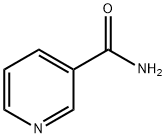FlavinAdenineDinucleotide , 97% , 146-14-5
CAS NO.:146-14-5
Empirical Formula: C27H33N9O15P2
Molecular Weight: 785.55
MDL number: MFCD00041835
EINECS: 205-663-1
| Pack Size | Price | Stock | Quantity |
| 5mg | RMB121.60 | In Stock |
|
| 25mg | RMB384.00 | In Stock |
|
| 100mg | RMB1024.00 | In Stock |
|
| 500mg | RMB3184.00 | In Stock |
|
| others | Enquire |
PRODUCT Properties
| Density | 2.08±0.1 g/cm3(Predicted) |
| storage temp. | −20°C |
| solubility | Methanol (Slightly, Heated), Water (Slightly) |
| pka | 1.13±0.50(Predicted) |
| form | powder |
| color | orange |
| Merck | 4091 |
| Stability: | Stable. Incompatible with strong oxidizing agents. |
| InChIKey | VWWQXMAJTJZDQX-ZGGJIJKNNA-N |
| CAS DataBase Reference | 146-14-5 |
| EPA Substance Registry System | Riboflavin 5'-(trihydrogen diphosphate), P'.fwdarw.5'-ester with adenosine (146-14-5) |
Description and Uses
Flavin adenine dinucleotide (FAD) is a cofactor for cytochrome-b5 reductase, the enzyme that maintains hemoglobin in its functional reduced state, and for glutathione reductase. This enzyme also protects erythrocytes from oxidative damage. FAD is a redox cofactor of several essential reactions in metabolism. This cofactor exists in two redox states, with FAD and FADH2 being the oxidized and reduced forms, respectively. FAD is formed of a riboflavin moiety (vitamin B2) coupled to a phosphate group of an ADP molecule. The reaction starts with the conversion of riboflavin into flavin mononucleotide catalyzed by riboflavin kinase. Flavin mononucleotide is subsequently transformed into FAD by adding an AMP moiety from ATP catalyzed by FAD-synthase. Therefore, FAD availability is tightly dependent on vitamin B2 and energy metabolism[1].
Labelled Flavine Adenine xidase. Riboflavin kinase tumor necrosis factor receptor 1 NADPH oxidase
Safety
| Symbol(GHS) |  GHS07 |
| Signal word | Warning |
| Hazard statements | H315-H319-H335 |
| Precautionary statements | P280-P302+P352-P362+P364 |
| Safety Statements | 24/25 |
| WGK Germany | 3 |
| RTECS | AU7470000 |
| F | 8-10-21 |
| HS Code | 29349990 |


